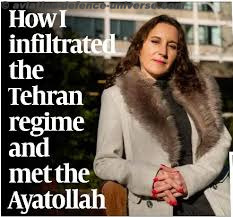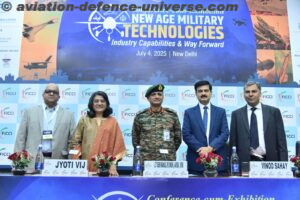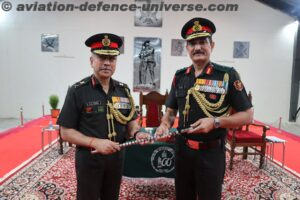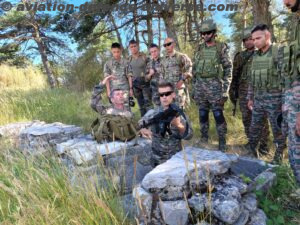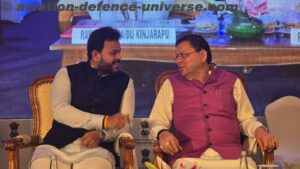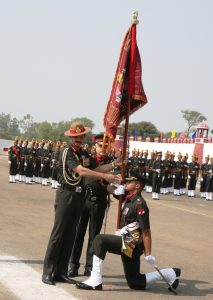
By Col NB Saxena
Sagar. 04 November 2016. It was a moment of pride and time to revel for 20 Mahar and 21 Mahar Battalions of the Mahar Regiment , on the occasion of Platinum Jubilee of the Regiment. Chief of the Army Staff General Dalbir Singh, on behalf of the President of India, presented the ‘President’s Colours’ to these two young battalions.
To commemorate this historic event, the Chief of the Army Staff released a “First Day Cover”. The Chief of Army Staff also released a book on Late General K V Krishna Rao, PVSM and comic book on Major R Parameswaran, Param Vir Chakra.
The Colour Presentation Parade was held at the Anusuya Prasad Parade Ground named after the youngest Mahavir Chakra recipient of the Indian Army, who with only 10 days of service laid down his life in the battle of Shamsher Nagar during 1971 Indo-Pak war.
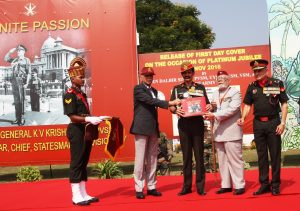
Release of Book Saga of Gen KV Krishna Rao
The Regiment has 09 Battle Honours, 12 Theatre Honours, 08 COAS Unit Citations, 19 GOC-in-C Unit Appreciations and scores of gallantry awards to its credit.
Although it was originally intended to be a regiment consisting of troops from the Mahars in Maharashtra, the Mahar Regiment is one of the only regiments in the Indian Army that is composed of troops from all communities and regions of India.
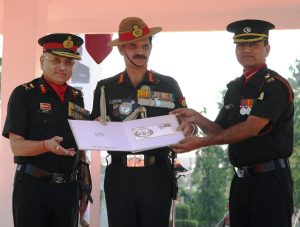
In the July 1941, B. R. Ambedkar was appointed to the Defence Advisory Committee of the Viceroy’s Executive Council. He used this appointment to exert pressure within the military establishment for a Mahar regiment. He also appealed to the Mahars to join the Army in large numbers. In October, the Army gave in, and the 1st Battalion of the Mahar Regiment was raised in Belgaum under Lt. Col. HJR Jackson of the 13th Frontier Force Rifles and Sub. Maj. Sheikh Hassnuddin. The 2nd Battalion was raised in Kamptee in June 1942 under Lt. Col. JWK Kirwan and Sub. Maj. Bholaji Ranjane.
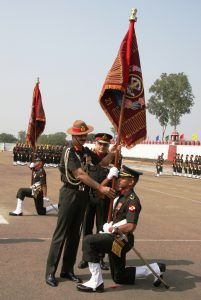
A cap badge was designed for the Regiment by Capt. EEL Mortlemans, an officer of 2nd Mahar. The badge featured the Koregaon Pillar over the word “MAHAR”. The third battalion, the 25th Mahars, was raised in Belgaum in the August 1942 by Lt. Col V. Chambier and Sub. Maj. Sardar Bahadur Ladkojirao Bhonsale, and the 3rd Mahars were raised in Nowshera by Lt. Col. RND Frier and Sub. Maj. Bholaji Ranjane.
During the War, the 1st and 3rd Mahars served in the North-West Frontier Province, while the 2nd and 25th Battalions were employed on internal security duties within the country. The 2nd Battalion also saw service in the Burma Campaign as a part of the 23rd Indian Division, where they suffered 5 casualties and had one officer Mentioned in dispatches. They also served in Iraq after the War as a part of PAIFORCE. In 1946, the 25th Mahars were disbanded, along with many other garrison battalions of the Indian Army. Its officers and men were largely absorbed by the other three battalions of the Regiment.
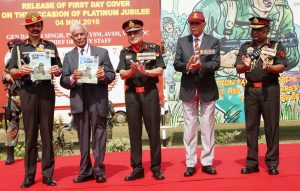
In the October 1946, the Regiment was converted into a Machine Gun Regiment, and the Regimental Centre was established at Kamptee. Following conversion of the Regiment to a machine-gun regiment, the cap-badge was changed. The new badge had two crossed Vickers machine guns over the Koregaon Pillar, over a scroll that said “The Mahar MG Regiment”. The three surviving battalions of the regiment served as a part of the Punjab Boundary Force, and took part in escorting refugees during the Partition of India.
The Regiment has taken part in all of India’s major military operations since 1947. Just as the Mahars have survived and prospered, so has the Mahars’ military legacy.














